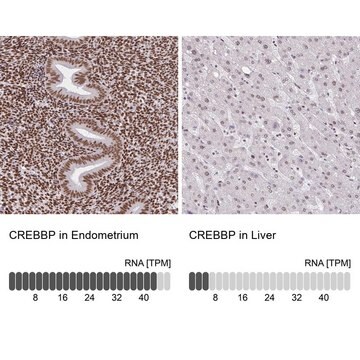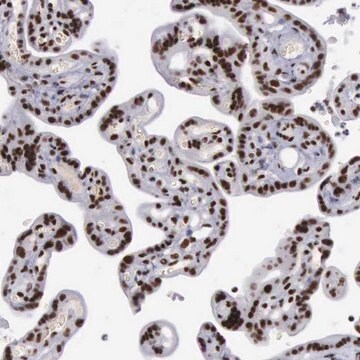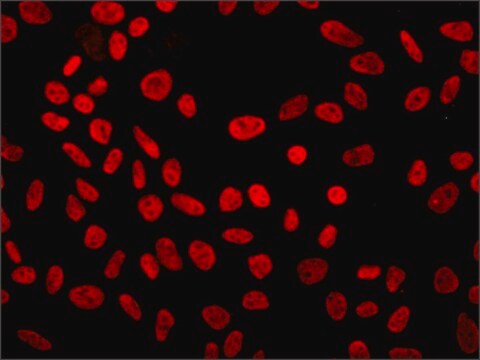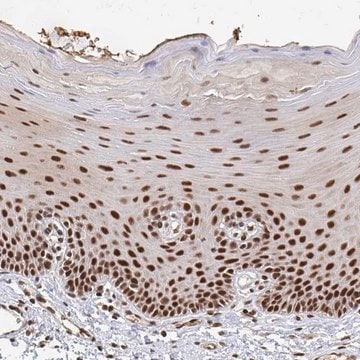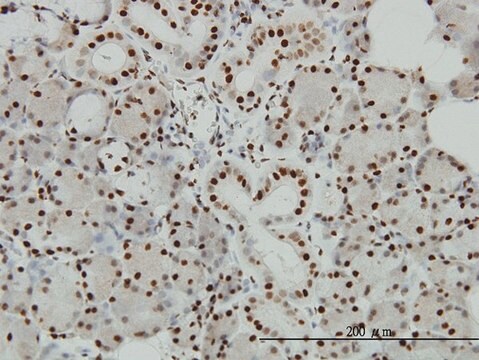推薦產品
生物源
rabbit
共軛
unconjugated
抗體表格
affinity isolated antibody
抗體產品種類
primary antibodies
無性繁殖
polyclonal
產品線
Prestige Antibodies® Powered by Atlas Antibodies
形狀
buffered aqueous glycerol solution
物種活性
human
技術
immunofluorescence: 0.25-2 μg/mL
immunohistochemistry: 1:200-1:500
免疫原序列
FLPQTQFPSQGMNVTNIPLAPSSGQAPVSQAQMSSSSCPVNSPIMPPGSQGSHIHCPQLPQPALHQNSPSPVPSRTPTPHHTPPSIGAQQPPATTIPAPVPTPPAMPPGPQSQALHPPPRQTPTPPTTQLPQQ
UniProt登錄號
運輸包裝
wet ice
儲存溫度
−20°C
目標翻譯後修改
unmodified
基因資訊
human ... EP300(2033)
尋找類似的產品? 前往 產品比較指南
一般說明
The gene EP300 (E1A binding protein p300) is mapped to human chromosome 22q13.2. The encoded protein contains a HAT domain and binding sites for transcription factors.
免疫原
Histone acetyltransferase p300 recombinant protein epitope signature tag (PrEST)
應用
All Prestige Antibodies Powered by Atlas Antibodies are developed and validated by the Human Protein Atlas (HPA) project and as a result, are supported by the most extensive characterization in the industry.
The Human Protein Atlas project can be subdivided into three efforts: Human Tissue Atlas, Cancer Atlas, and Human Cell Atlas. The antibodies that have been generated in support of the Tissue and Cancer Atlas projects have been tested by immunohistochemistry against hundreds of normal and disease tissues and through the recent efforts of the Human Cell Atlas project, many have been characterized by immunofluorescence to map the human proteome not only at the tissue level but now at the subcellular level. These images and the collection of this vast data set can be viewed on the Human Protein Atlas (HPA) site by clicking on the Image Gallery link. We also provide Prestige Antibodies® protocols and other useful information.
The Human Protein Atlas project can be subdivided into three efforts: Human Tissue Atlas, Cancer Atlas, and Human Cell Atlas. The antibodies that have been generated in support of the Tissue and Cancer Atlas projects have been tested by immunohistochemistry against hundreds of normal and disease tissues and through the recent efforts of the Human Cell Atlas project, many have been characterized by immunofluorescence to map the human proteome not only at the tissue level but now at the subcellular level. These images and the collection of this vast data set can be viewed on the Human Protein Atlas (HPA) site by clicking on the Image Gallery link. We also provide Prestige Antibodies® protocols and other useful information.
生化/生理作用
EP300 (E1A binding protein p300) gene encodes the transcriptional co-activator protein called p300. It is a histone acetyl transferase that regulates gene expression through various signal-transduction pathways. It is involved in chromatin remodeling, cell proliferation and differentiation. It specifically binds to phosphorylated CREB protein and controls cAMP-gene regulation. In response to DNA damage, it acetylates TP53 and regulates its DNA-binding and transcription functions. It functions as a tumor suppressor. Mutations in this gene may be linked to human cancers. Defects in this gene cause Rubinstein-Taybi syndrome that is characterized by growth retardation, facial dysmorphisms, skeletal abnormalities and mental retardation.
特點和優勢
Prestige Antibodies® are highly characterized and extensively validated antibodies with the added benefit of all available characterization data for each target being accessible via the Human Protein Atlas portal linked just below the product name at the top of this page. The uniqueness and low cross-reactivity of the Prestige Antibodies® to other proteins are due to a thorough selection of antigen regions, affinity purification, and stringent selection. Prestige antigen controls are available for every corresponding Prestige Antibody and can be found in the linkage section.
Every Prestige Antibody is tested in the following ways:
Every Prestige Antibody is tested in the following ways:
- IHC tissue array of 44 normal human tissues and 20 of the most common cancer type tissues.
- Protein array of 364 human recombinant protein fragments.
聯結
Corresponding Antigen APREST73567
外觀
Solution in phosphate-buffered saline, pH 7.2, containing 40% glycerol and 0.02% sodium azide
法律資訊
Prestige Antibodies is a registered trademark of Merck KGaA, Darmstadt, Germany
免責聲明
Unless otherwise stated in our catalog or other company documentation accompanying the product(s), our products are intended for research use only and are not to be used for any other purpose, which includes but is not limited to, unauthorized commercial uses, in vitro diagnostic uses, ex vivo or in vivo therapeutic uses or any type of consumption or application to humans or animals.
Not finding the right product?
Try our 產品選擇工具.
儲存類別代碼
10 - Combustible liquids
水污染物質分類(WGK)
WGK 1
閃點(°F)
Not applicable
閃點(°C)
Not applicable
個人防護裝備
Eyeshields, Gloves, multi-purpose combination respirator cartridge (US)
分析證明 (COA)
輸入產品批次/批號來搜索 分析證明 (COA)。在產品’s標籤上找到批次和批號,寫有 ‘Lot’或‘Batch’.。
Emma J Bryan et al.
International journal of cancer, 102(2), 137-141 (2002-10-18)
The putative tumour suppressor gene EP300 is located on chromosome 22q13 which is a region showing frequent loss of heterozygosity (LOH) in colon, breast and ovarian cancers. We analysed 203 human breast, colon and ovarian primary tumours and cell lines
Zimam Mahmud et al.
Biochemical pharmacology, 163, 391-403 (2019-03-14)
E-cadherin transcriptional activator EP300 is down-regulated in metaplastic breast carcinoma, a rare form of triple negative and E-cadherin-negative aggressive breast cancer with a poor clinical outcome. In order to shed light on the regulation of E-cadherin by EP300 in breast
Soeren Torge Mees et al.
International journal of cancer, 126(1), 114-124 (2009-07-02)
Genetic and epigenetic alterations during development of pancreatic ductal adenocarcinomas (PDACs) are well known. This study investigates genetic and epigenetic data together with tumor biology to find specific alterations responsible for metastasis formation. Using 16 human PDAC cell lines in
Bo Ram Kim et al.
Molecular & cellular proteomics : MCP, 16(10), 1864-1888 (2017-08-11)
Lung cancer is the leading cause of cancer mortality worldwide, with squamous cell carcinoma (SQCC) being the second most common form. SQCCs are thought to originate in bronchial basal cells through an injury response to smoking, which results in this
Zhenhua Liu et al.
Journal of cellular and molecular medicine, 22(9), 4161-4170 (2018-07-06)
Oestrogen receptor ɑ (ERɑ) is overexpressed in two-thirds of all breast cancers and involves in development and breast cancer progression. Although ERɑ-positive breast cancer could be effective treated by endocrine therapy, the endocrine resistance is still an urgent clinical problem.
我們的科學家團隊在所有研究領域都有豐富的經驗,包括生命科學、材料科學、化學合成、色譜、分析等.
聯絡技術服務
